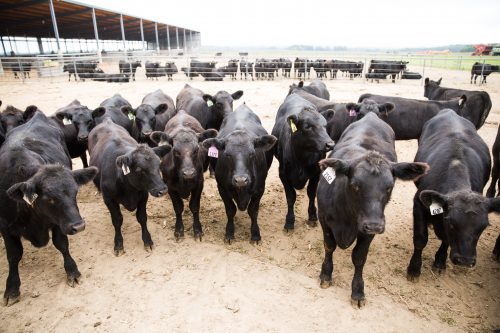Cattle Feeding Projections – January 2018
Posted: January 22, 2018 | Written By: Simon Kern, M.S.

Cattle Feeding Projections – January 2018
Estimated cattle on feed numbers for January were up 1.2 million head over a year ago. While there are increases in all weight brackets, the largest increase is in lightweight feeder calves. A mild November and first half of December allowed for rapid growth and pushed carcass weights over the previous year’s for the first time in all of 2017. This is not expected to last long with severe cold setting in across a majority of the country in late December and early January. Carcass weights for the first week of 2018 are now holding steady to the previous year at 836 pounds. Colder weather, especially in the southern U.S., has also put a dent in the domestic hay supply with stocks down 10% and reaching levels not seen since drought ravaged 2012. Hay production in 2017 was negatively impacted by multiple environmental events across the country (floods, hurricanes, fires, etc.) leaving stocks smaller than normal and less able to absorb this increase in demand. Higher prices throughout most of 2018 should be expected.
The effects of cold weather have also been felt on the demand side of the equation. While post-Holiday demand is expected to soften, the brutal cold will exacerbate this through weaker foodservice demand which has a greater impact on beef than competing proteins. Still consumer confidence, both domestically and internationally, was up throughout 2017 and looks positive going into 2018. This should support economic growth, domestic consumer spending (hopefully on beef), and export demand. 2017 was a banner year for beef exports (+11.5% over 2016) and wrapped up with December figures expected to come in at a 2.7% year over year increase (just shy of August’s all-time record). Expectations for export growth in 2018 are more modest, but still positive at +4.7%. U.S. beef should remain competitive in the global marketplace due to an expanded supply and competitive prices. Domestic beef availability increased by 4.6% (from 54.3 to 56.8 pounds per capita). The marketplace absorbed this increase quite well as retail prices only fell 1% (3% adjusted for inflation), indicating strong domestic demand.
Changes month over month on our feeding projections:
- Significantly softer feeder purchase prices across the board (Holsteins -$15.00-16.50/cwt, beef calves -$1.50-2.50/cwt, beef yearlings -$10.00/cwt).
- Expected fed beef cattle prices mostly stronger with all classes +$2.50-4.00/cwt.
- Increased cost of gain (+$3.50-4.00/cwt): corn +$0.14/bushel, corn silage unchanged, corn stalks unchanged, grass hay unchanged, DDGS +$7.50/ton, MDGS +$10/ton, and pelleted soy hulls +$5/ton.
- Strong profitability persists across the board for all classes of Holsteins.
- Sharp improvements in the profit outlook for beef steers and heifers, but most classes remain well in the red.
As always, please note the difference in cost of gain ($7-12/cwt) and potential profits ($50-100+/head) between the high and low efficiency projections. Ensuring proper management and animal husbandry can make the world of difference in this regard. With Midwest winter conditions here to stay for the next couple month, it is imperative to focus on managing pens and bunks through these tough environmental conditions. Remember to keep this as a priority as profits on well managed cattle are hard to come by in today’s market and virtually impossible to find on those which are not managed to their full potential.
For more specific projections, please contact your Form-A-Feed representative.